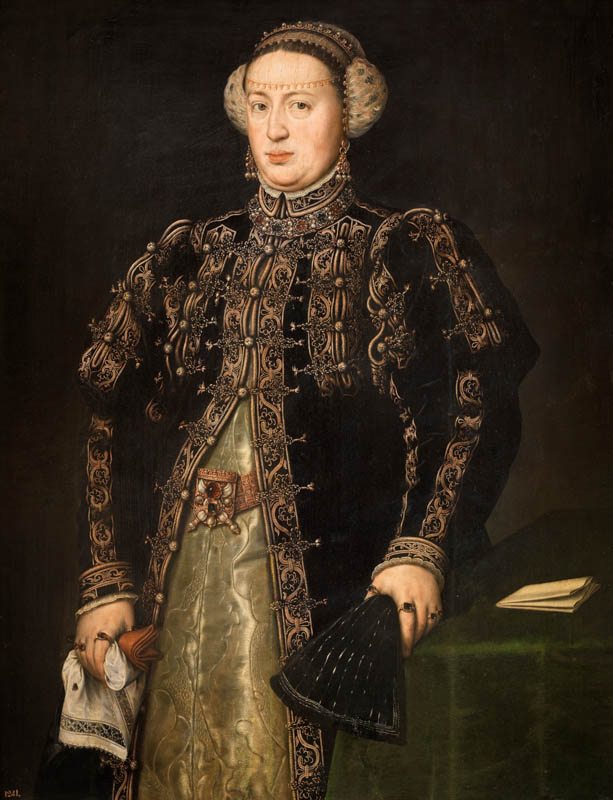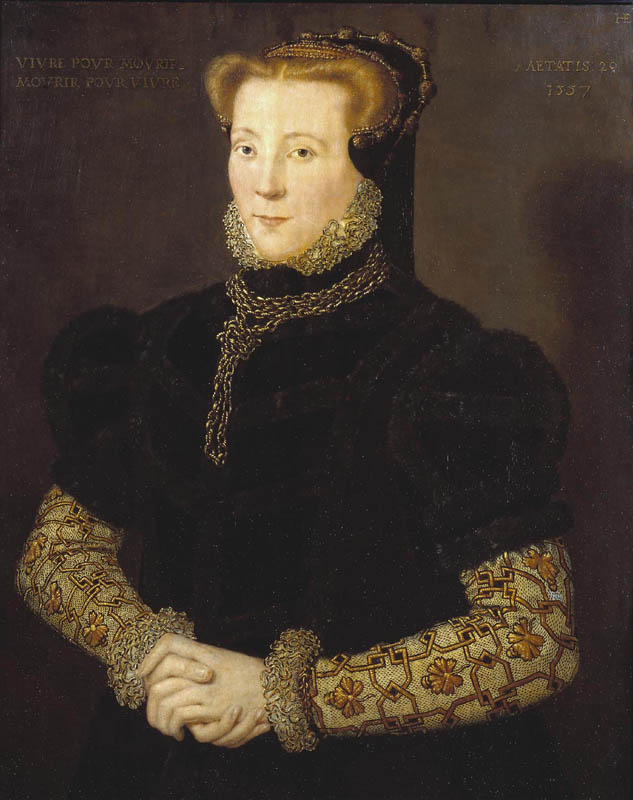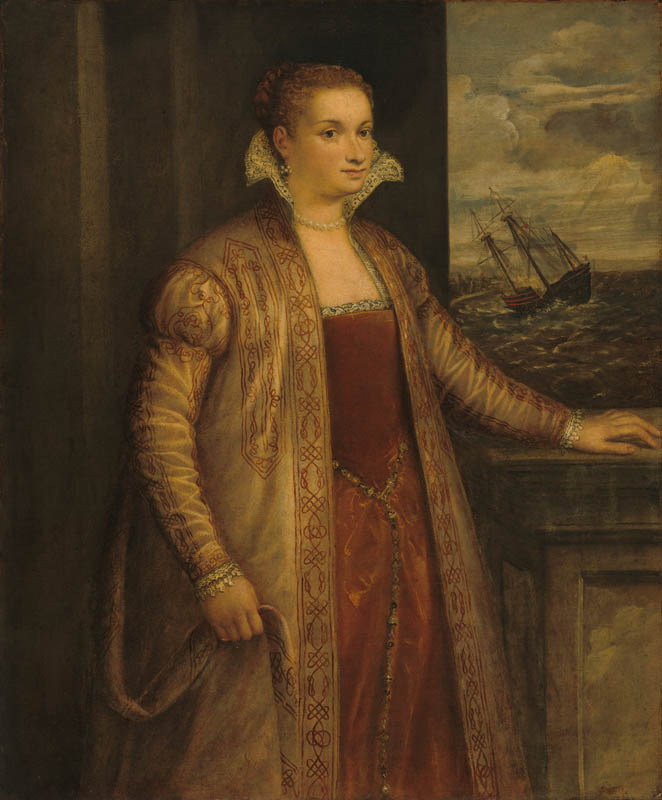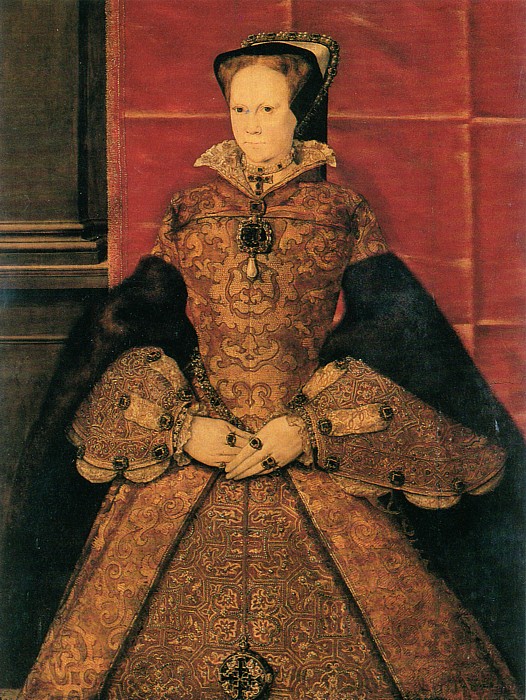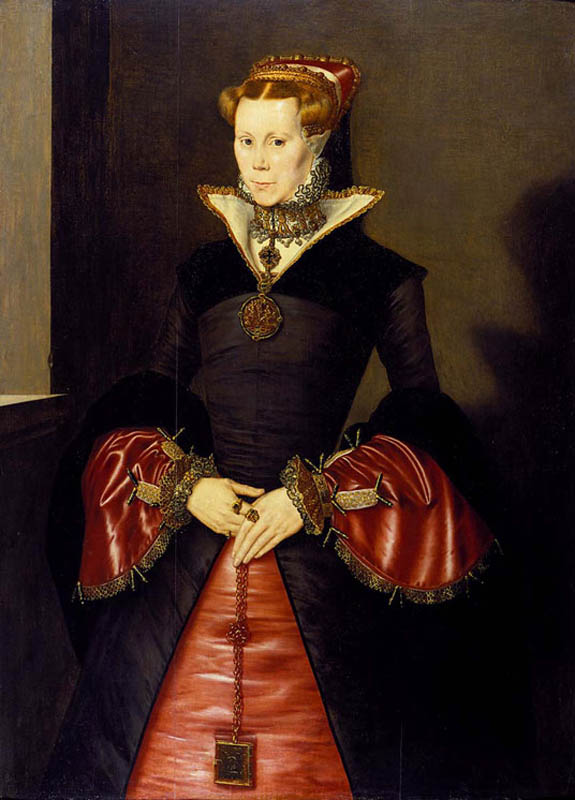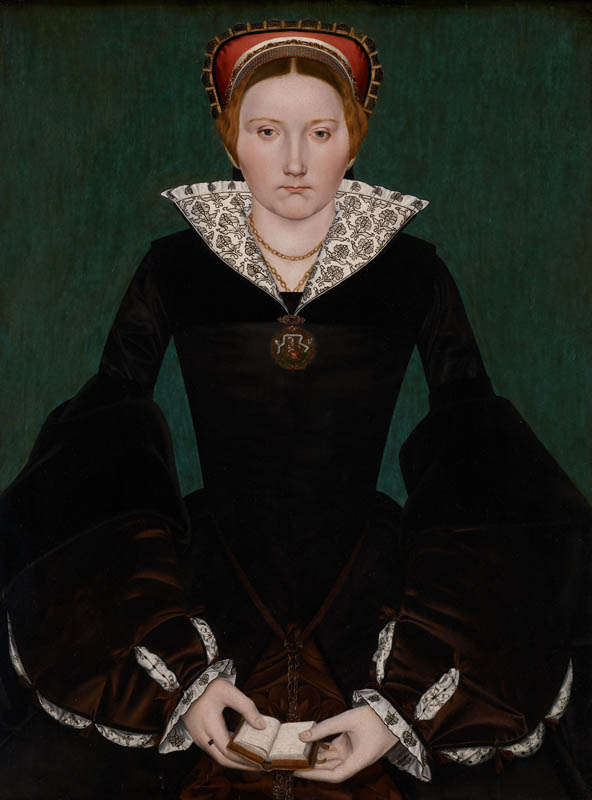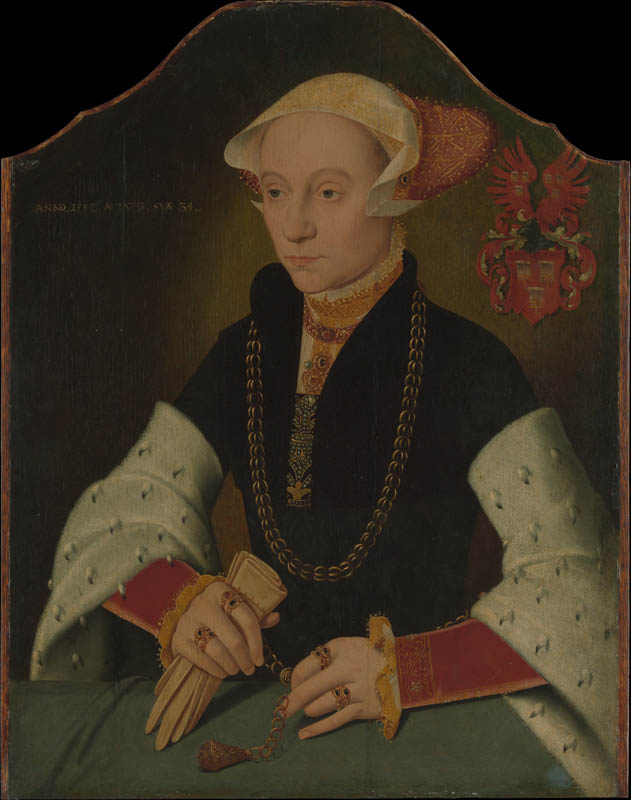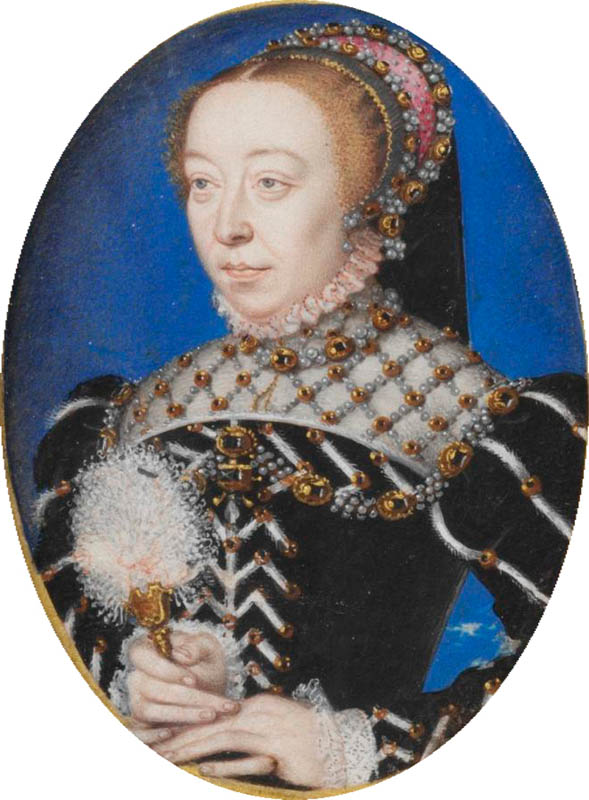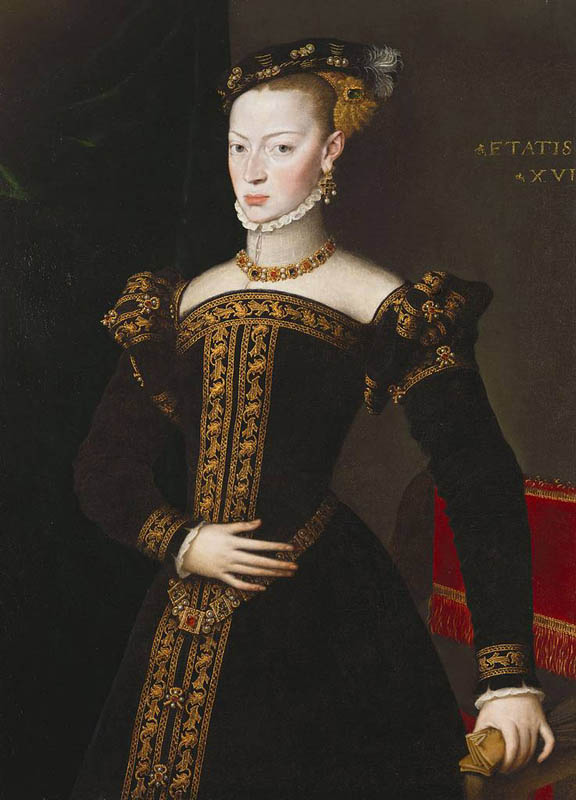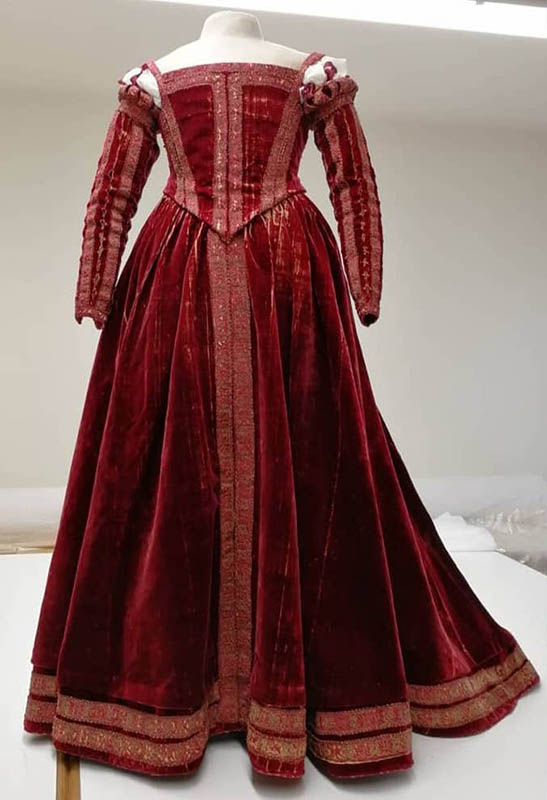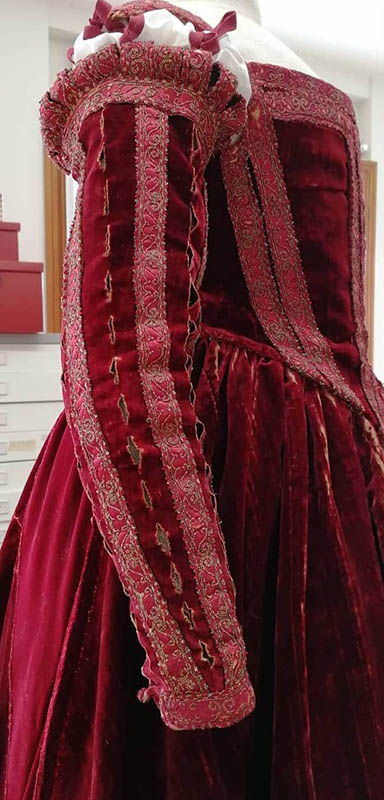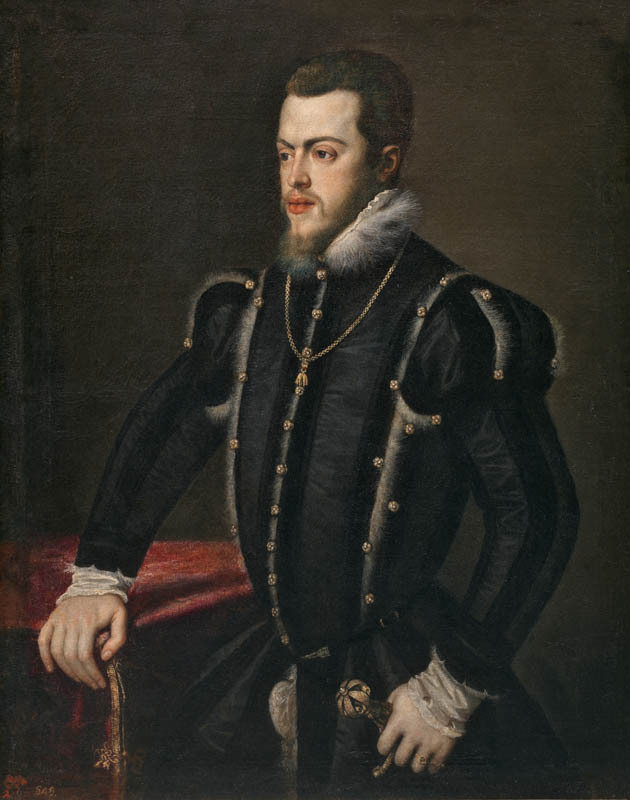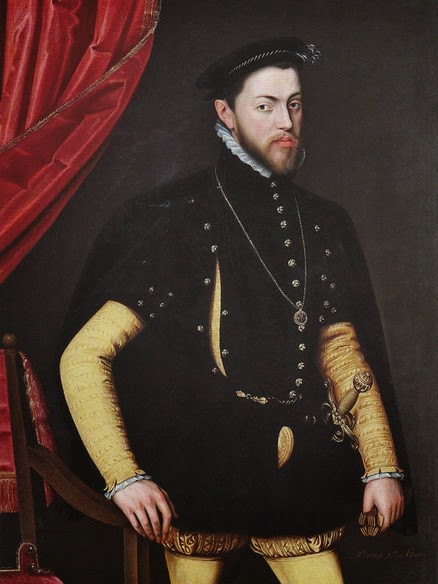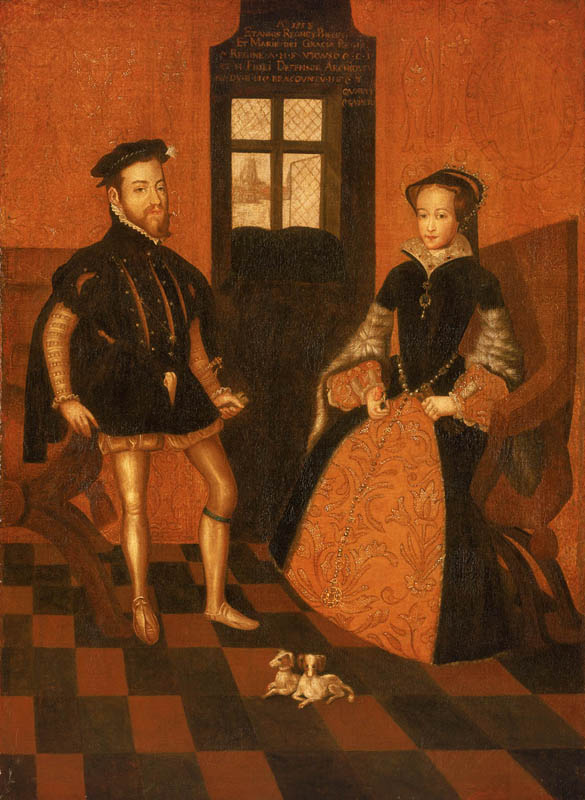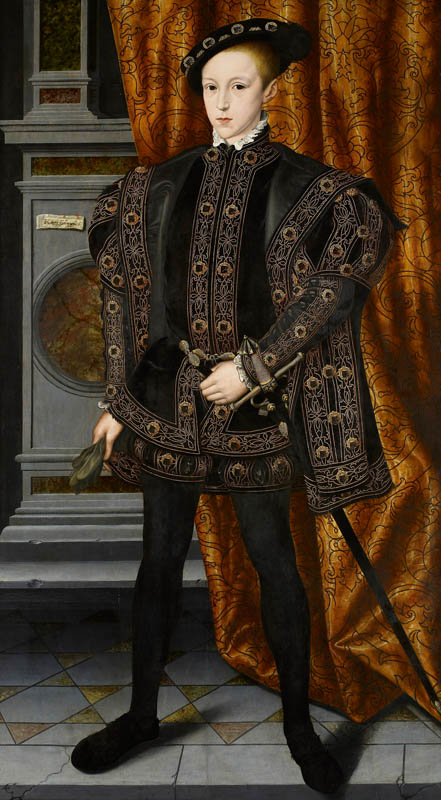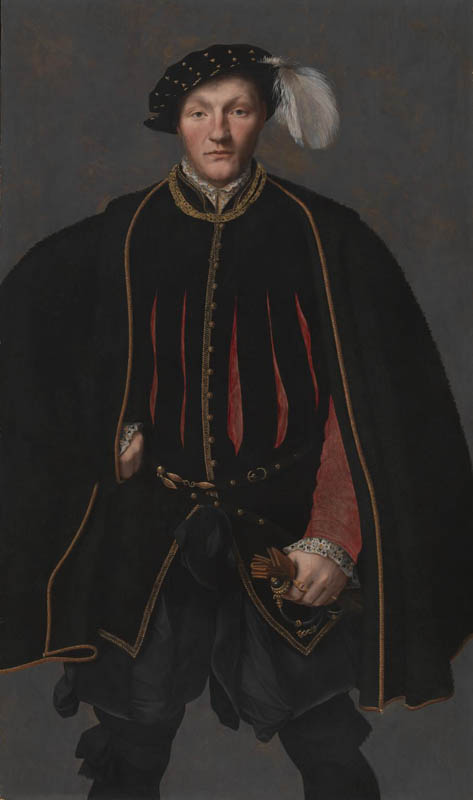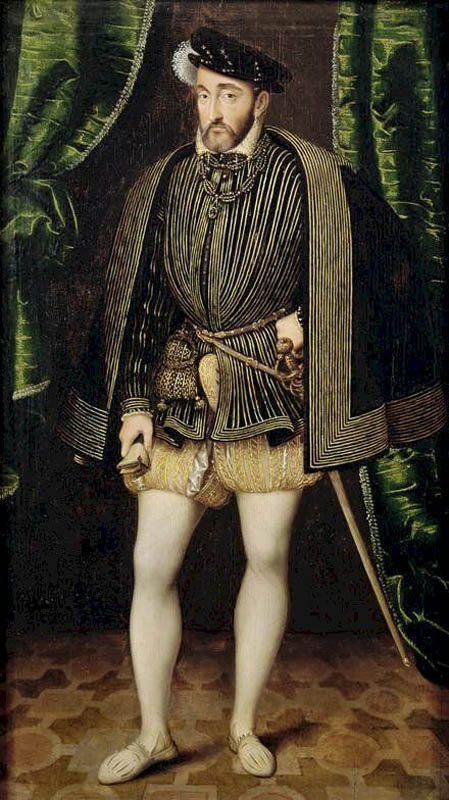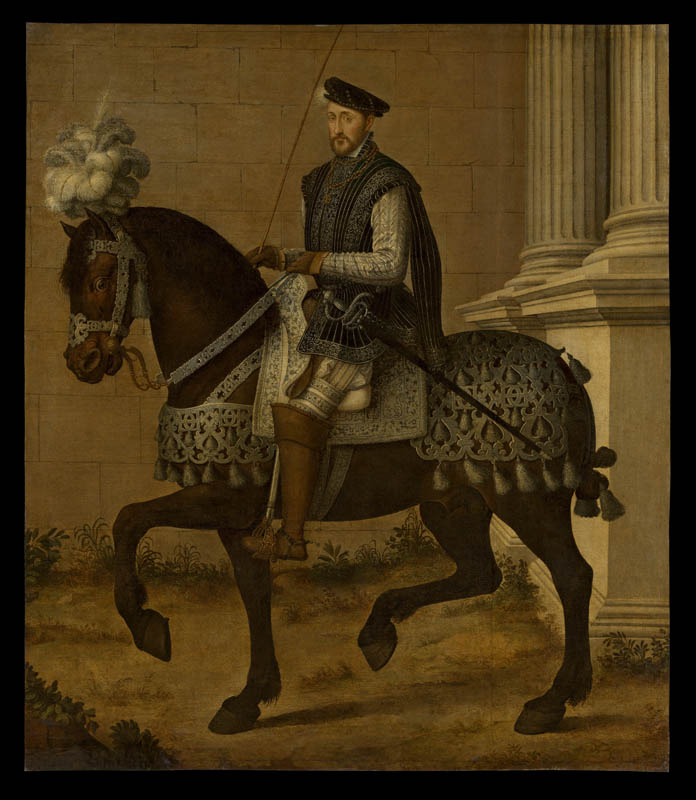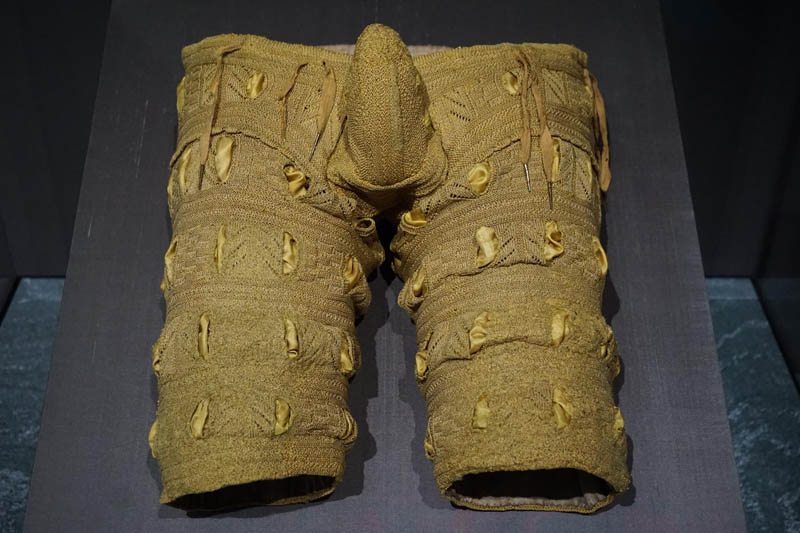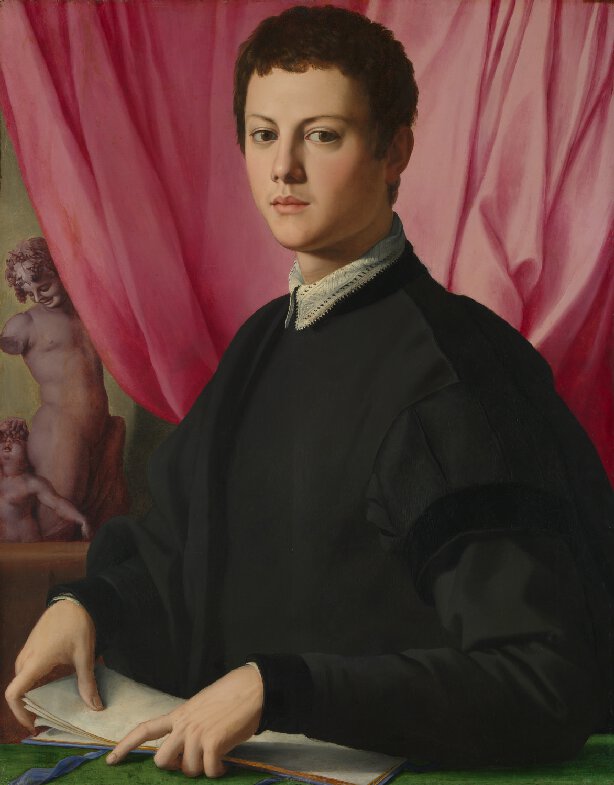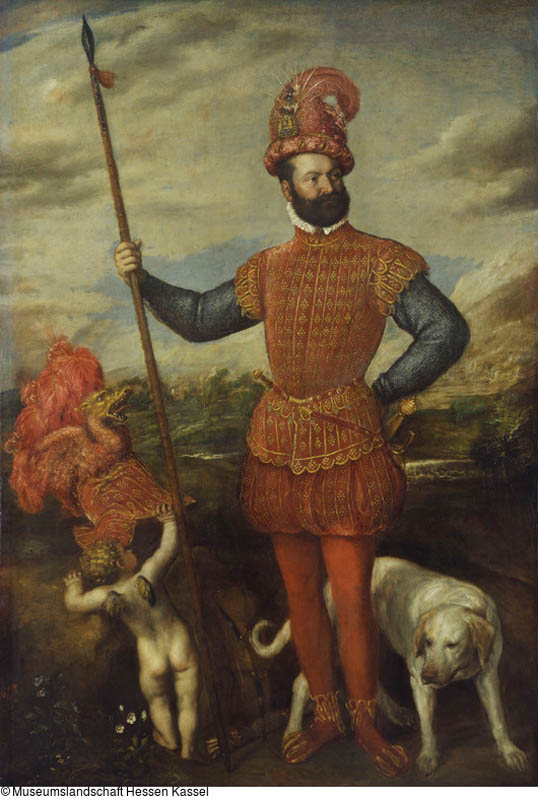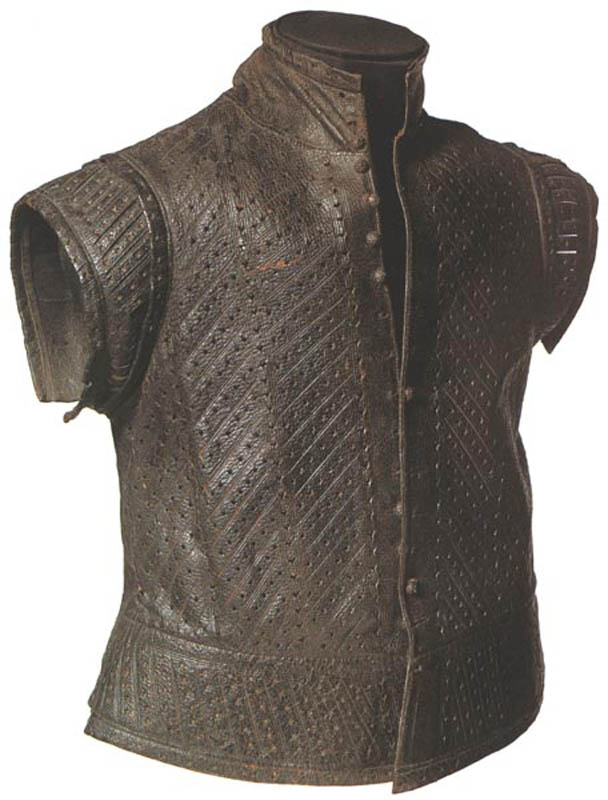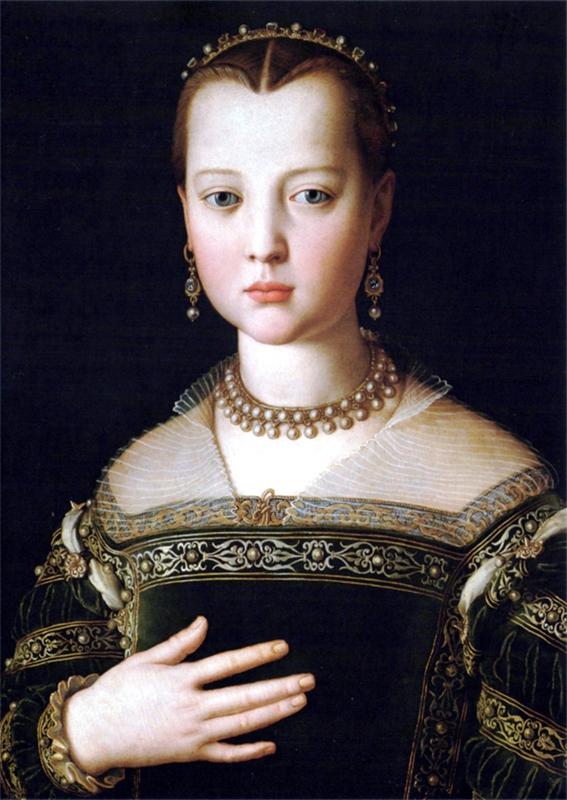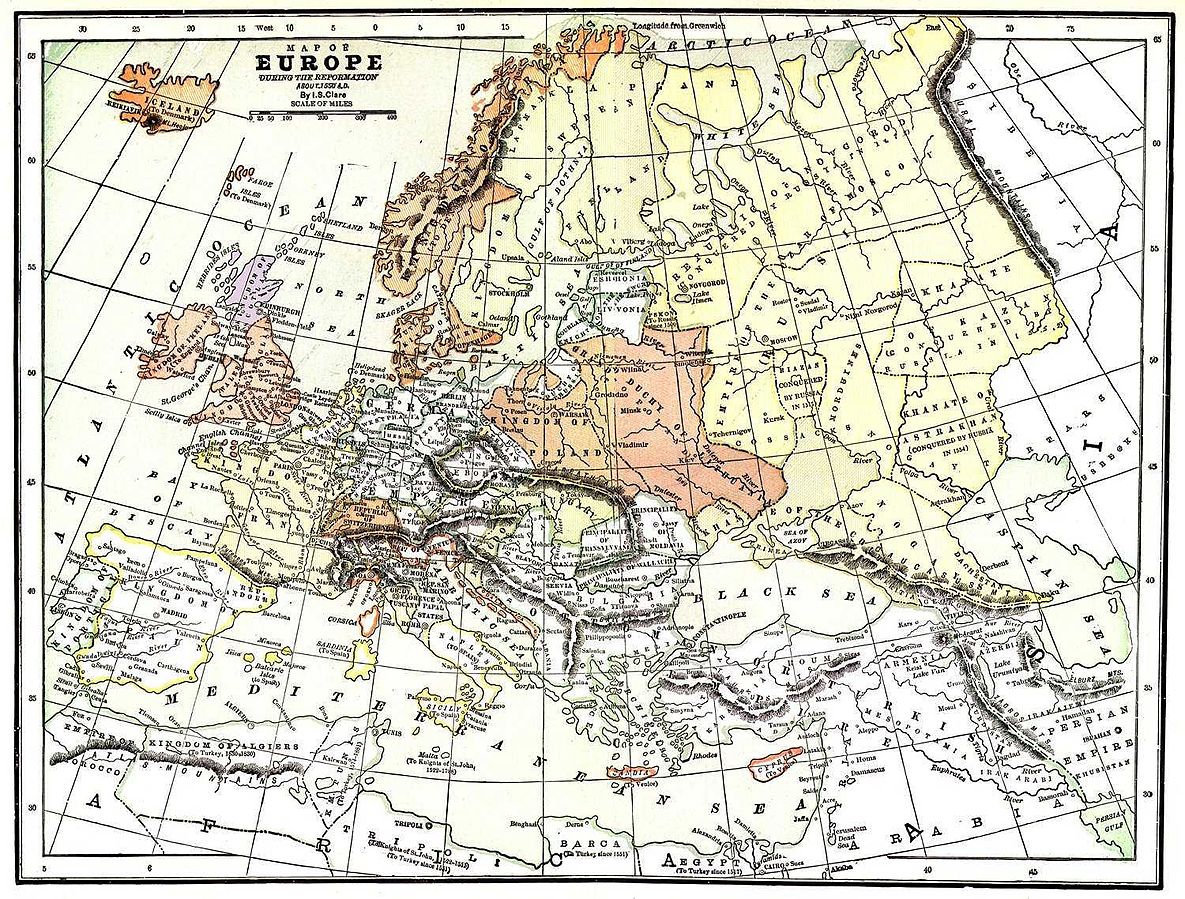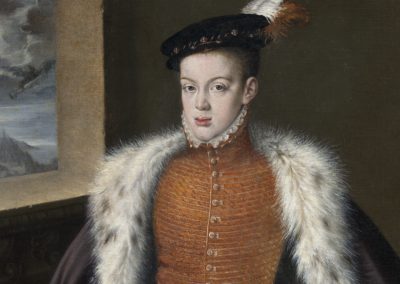OVERVIEW
Spanish fashion was ascendant in the 1550s, from the loose women’s gown—the ropa—and the Spanish farthingale in women’s dress to the narrow-cut jerkins and tight sleeves of Philip II and the must-have men’s outerwear piece, the Spanish cape.
Womenswear
The trends of the late 1540s continue in the early 1550s. The newly dominant rigid silhouette created by stiffening the bodice and wearing the conical Spanish farthingale remained in place. As always, the foundation of womenswear was the chemise, which now was often topped by stays (an early form of corsetry) and a kirtle (which more often now referred to a petticoat skirt), with a gown worn as the final layer.
In the 1550s, a new garment became popular across Europe, as François Boucher explains in A History of Costume in the West (1997):
“the ropa, which may, however, have been Portuguese in origin; it was a sort of loose-waisted mantle open in front, in which some authors have seen the continuation of the fifteenth-century surcoat. It often had double funnel sleeves, one part of which could be worn hanging, in accordance with a purely Spanish tradition.” (227)
Catherine of Austria, wife of King John III of Portugal, wears a ropa in Anthonis Mor’s 1552 portrait (Fig. 1).
Fig. 1 - Anthonis Mor (Netherlandish, 1516-1576). Catherine of Austria, Wife of King John III of Portugal, 1552-53. Oil on panel; 107 x 84 cm. Madrid: Museo del Prado, P002109. Source: Prado
Fig. 2 - Hans Eworth (Flemish, 1520-1574). Mary I of England, 1555-58. London: Dickinson Gallery. Source: Wikipedia
Fig. 3 - Hans Eworth (Flemish, 1520-1574). Portrait of an Unknown Lady, 1557. Oil on wood; 59.7 x 48.3 cm. London: Tate, T00606. Source: Tate
Fig. 4 - Titian (Venetian, 1488-1576). Emilia di Spilimbergo, ca. 1560. Oil on canvas; 122 x 106.5 cm (48 1/16 x 41 15/16 in). London: National Gallery of Art, 1942.9.82. Widener Collection. Source: NGA
From Portugal it spread to Spain and was soon adopted by Mary I of England, as Daniel Delis Hill explains in A History of World Costume and Fashion (2011):
“In 1554, Mary I, daughter of Henry VIII and Catherine, married the future Spanish king, Philip II. The queen and the English court eagerly copied the styles of the Spanish entourage.” (375-76)
Mary wears a black, fur-lined ropa style gown adorned with decorative silver aiguillettes in a portrait by Hans Eworth (Fig. 2). Like Mary, an unknown woman also painted by Eworth (Fig. 3) wears a dark gown which contrasts with her elaborate silver and gold brocade sleeves. Both women’s outfits feature elaborate chemise frills that will very soon become separate ruffs. Boucher dates the first appearance of the ruff to 1555 (227).
A version of the loose ropa began to be worn all over Europe, under various names: “the sumarra in Italy, the marlotte in France and the vlieger in Holland” (Boucher 224). Emilia di Spilimbergo wore a similar loose gown uncinched at the waist in her portrait by Titian (Fig. 4).
Fig. 5 - Hans Eworth (Flemish, 1520-1574). Mary I of England, 1554. Oil on oak panel; 104 x 78.5 cm (41 x 31 in). London: Society of Antiquaries of London, LDSAL 336. Source: Wikipedia
Fig. 6 - Hans Eworth (Flemish, 1520-1574). Mary Tudor, 1553. Oil on panel. Cambridge: Fitzwilliam Museum, PD.1-1963. Source: Fitzwilliam
Fig. 7 - Artist unknown (English). Portrait of a Noblewoman, ca. 1550. Oil on panel; 76.52 x 57.63 cm (30 1/8 x 22 11/16 in). Minneapolis Institute of Art, 87.6. Source: MIA
The fitted silhouette commonly seen in the 1540s remained popular, however. Women could choose between loose ropa-style gowns and more fitted ones as Jane Ashelford explains in A Visual History of Costume: The Sixteenth Century (1983):
“By the 1550s women had a choice of two styles of gown to wear over the bodice and skirt. The loose gown fitted across the shoulders to fall in set folds spreading outwards to the ground… The gown could be closed by means of buttons, bows and aglets… [or] The closed gown fitted to the waist and then extended over the hips to fall in folds to the ground.” (23)
Mary I of England wears just such a gown, with a highly ornate cloth-of-gold forepart, in a 1554 portrait (Fig. 5). The same silhouette can be seen in two other portraits of women at the English court (Figs. 6-7). Both of these portraits feature black gowns, which contrast dramatically with the white of their flared, standing chemise collars decorated with embroidery. All three women still have large funnel sleeves and then undersleeves with open seams closed by broaches or aiguillettes where the embroidered chemise is puffed out. The small prayer book that hangs from the girdle in figure 6 and is held open in figure 7 had become a fashionable accessory. All the English women (Figs. 2-3, 5-7) wear the “English version of the French hood [where] the top of the crown is flattened across the head to turn wide of the temples and then turn in at an angle to end over the ears” (Ashelford 47).
Fig. 8 - Artist unknown. Portrait of Catherine de' Medici (1519-1589), 1559. Oil on canvas; 194 × 110 cm (76.4 × 43.3 in). Florence: Uffizi Gallery, Inv. 1890: inv. 2448. Source: Wikipedia
Fig. 9 - Barthel Bruyn the Younger (German, ca. 1530-1610). Portrait of a Woman of the Slosgin Family of Cologne, 1557. Oil on oak; 45.1 x 35.9 cm (17 3/4 x 14 1/8 in). New York: The Metropolitan Museum of Art, 32.100.50. The Friedsam Collection, Bequest of Michael Friedsam, 1931. Source: The Met
Fig. 10 - François Clouet (French, 1510-1572). Catherine de'Medici (1519-1589), ca. 1555. Watercolor on vellum; 60 x 44 cm. London: Victoria & Albert Museum, P.26-1954. Source: V&A
Catherine de’ Medici, Queen of France, wears the more traditional French hood in a 1559 portrait (Fig. 8). Her dress conforms to the same rigid silhouette seen at the English court based on the Spanish farthingale and the beginnings of corsetry, as Millia Davenport explains in The Book of Costume (1948), writing that her:
“gown is of black velvet, embroidered with gold and lines of pearls, set with sapphires at their intersections; the underdress of pink satin…. Another of Catherine’s introductions from Italy was the corset of flexible steel, such as she wears with the vertugale under this gown.” (475)
Her funnel-shaped sleeves are turned back to reveal a lynx fur lining, creating enormous cuffs that nearly reach her shoulders. Ashelford notes that this was a common decorative choice: “Contrasting the dark material of the gown with a soft fur lining was a fashion that appears in many portraits of the 1550s and 1560s” (59).
We see another example in Germany, in Barthel Bruyn the Younger’s portrait of a woman of the Slosgin family of Cologne (Fig. 9), where the sleeves are instead lined with ermine (note the tails). Another portrait of Catherine (Fig. 10) again shows her wearing a French hood, but this time with a low-cut bodice with the neckline filled in by a jeweled partlet that ends in a ruffled collar edged in red embroidery. The black dress has large rolls at the shoulder and is clearly fur-lined as the regular openings reveal tufts of white fur.
Fig. 11 - Follower of Anthonis Mor (Netherlandish, 1512-1576). Joanna of Austria (1535-73), ca. 1552-53. Oil on canvas; 95.6 x 69.1 cm. Royal Collection Trust, RCIN 407223. Source: RCT
Fig. 12 - Designer unknown (Italian, 16th century). Red velvet dress, ca. 1550-60. Pisa: Museo di Palazzo Reale. Source: Instagram
Fig. 13 - Designer unknown (Italian, 16th century). Red velvet dress, sleeve detail, ca. 1550-60. Pisa: Museo di Palazzo Reale. Source: Instagram
Fig. 14 - Giovanni Battista Moroni (Italian, 1520/4 - 11579). Portrait of a Lady, perhaps Contessa Lucia Albani Avogadro, ca. 1556-60. Oil on canvas; 155 x 106.8 cm. London: National Gallery, NG1023. Bought, 1876. Source: National Gallery
Joanna of Austria, raised in Spain and future Princess of Portugal, reflects the somber fashions of the Spanish court, as the Royal Collection Trust explains:
“Joanna wears a formal black velvet gown, probably her bridal clothing from her marriage to John of Portugal in 1552 [See Fig. 2 in the Menswear section below]. It is embroidered in gold with intertwined capital ‘I’ letters, perhaps alluding to her husband’s name (Iohannes or Ioan) or her own name (Ioannae). Black clothing was particularly expensive, an intense deep black colour being costly to produce and hard to maintain over time. It was a colour much favoured at the Habsburg court and was commonly worn at weddings in the sixteenth century.”
Her sleeves have a puff of volume right at the shoulder, similar to menswear at the time; see a very similar sleeve style on her brother, Philip II in the Fashion Icon section below. The decoration along the top of the bodice and down the front of the bodice, as well as down the skirt, is very similar to the style of a surviving dress from Pisa (Figs. 12-13). That dress is made instead of red velvet, but likely was influenced by the Spanish fashion for this kind of decoration. The sleeves of the gown are also very regularly slashed in a vertical line (Fig. 13). While Joanna’s neckline is filled in by her chemise or a partlet, the Italian woman who wore this red dress may or may not have done so, as low necklines remained popular in Italy even as they disappeared elsewhere in Europe. An Italian woman painted by Giovanni Battista Moroni (Fig. 14) wears a red silk satin gown with slashed decoration on the bodice and the small puffed upper sleeves, here with transparent chemise fabric pulled out. While the bodice is rigid, the skirt falls in gentle folds suggesting she is not wearing the Spanish farthingale favored elsewhere, with volume instead created by pleats at the waistline as in the red velvet dress. She has red embroidery at her chemise cuffs reminiscent of the red embroidery at the collar frill of Catherine de’ Medici (Fig. 10).
While her hair is worn up, without any additional hat or hood, Joanna of Austria (Fig. 11) wears a typical Spanish hairstyle, as the Royal Collection Trust notes: “Joanna’s hairstyle, which is frizzed and set on the sides of the head beneath her masculine style bonnet, is distinctively Spanish and was known as ‘toca de cabos’.” The continuing adoption of menswear style elements continues trends we’d seen in the 1540s.
Fashion Icon: Philip II, King of Spain & of England
Fig. 1 - Titian (Venetian, 1488-1576). Philip II, 1549-50. Oil; 103 x 82 cm. Madrid: Museo del Prado, P000452. Source: Prado
Philip II ruled during the Spanish Golden Age and controlled a vast number of countries; he was
“King of Castile and Aragon (1556–98), King of Portugal (1581–98, as Philip I, Filipe I), King of Naples and Sicily (both from 1554), and jure uxoris King of England and Ireland (during his marriage to Queen Mary I from 1554 to 1558). He was also Duke of Milan. From 1555 he was lord of the Seventeen Provinces of the Netherlands.” (Wikipedia)
His style of dress exemplified Spanish taste and sobriety. He favored a simple palette of black and white (and gold). The dramatic shift in menswear tailoring back to the natural line after the broadness favored in the 1530s is evident in the narrow lines of Philip’s jerkins (Figs. 1-3). A portrait by Titian (Fig. 1) shows him in a fur-lined jerkin where the white tufts of fur appear through the seams, as seen above in the portrait of Catherine de’ Medici (Fig. 10 above). In a portrait by Anthonis Mor (Fig. 2), Philp also wears black and white, but here there is no extra padding from a fur lining and the open seams are instead held closed by broaches. His white satin doublet sleeves are regularly slashed on the diagonal, as is his jerkin, which also has regular embroidery or ribbon decoration down the torso. A portrait from about the same time (Fig. 3) also has Philip wearing a black jerkin, but now paired with a canary yellow doublet and paned trunk hose covered in regular pinked lines.
A portrait of Philp II with his wife Mary I of England shows him again in a black jerkin with long vertical open seams (Fig. 4), though here his doublet appears to be red. In all four portraits a pale codpiece contrasts with the rest of his dress and attracts attention. In the latter three portraits he wears a black bonnet with a small white feather. In all four he wears a sword, as was customary by this time. The Spanish wearing of black was a hallmark of Spanish/Hapsburg dress, but as noted above in reference to Philip’s sister, Joanna of Austria (Fig. 11) it was also a status symbol as rich black cloth was expensive to produce and maintain. Philip’s style would go on to have a strong influence on other European courts, as we’ll see below.
Fig. 2 - After Anthonis Mor (Netherlandish, 1512-1576). Phillip II (1527-1598), King of Spain, 1554-58. Oil on panel; 98.2 x 66.5 cm. Royal Collection Trust, RCIN 406044. Source: RCT
Fig. 3 - Jooris van der Straeten (Netherlandish, active 1527-1598). Philip II of Spain, ca. 1554. Oil on canvas. Source: Wikipedia
Fig. 4 - Lucas de Heere (Flemish, 1534-1584). Mary I of England, 1516-58 and Philip II of Spain, 1527-98, 1558. Oil on canvas; 106.1 x 77.4 cm. Greenwich: National Maritime Museum, BHC2952. Source: Royal Museums Greenwich
Menswear
Edward VI of England in a ca. 1550 portrait (Fig. 1) wears clothes similar to those of his father, Henry VIII, but in a somber color palette. The broad silhouette is conservative for the time, unlike the narrow lines of the more fashion-forward Philip II discussed above. Edward VI and his fellow young royal John, Prince of Portugal (Fig. 2) both still wear short gowns, but as we’ll see the Spanish cape becomes the more popular piece of outerwear in the 1550s. Doublets and jerkins fit tightly at the neck, with standing collars and shirts with a frill at the neck. Trunk hose are gaining volume and are often paned; they are worn with stockings and shoes often of the same color. Flat bonnets worn at an angle and often decorated with an ostrich feather remain popular. Swords hang from a belt/baldrick at the hip and gloves are often carried. Daggers are less frequently seen than previously.
Maximillian II, the Holy Roman Emperor and cousin of Philip II, shows the latest trends at his court in a 1550 portrait by Anthonis Mor (Fig. 3). The methodical regularity of the slashing on the jerkin and pinking on the doublet sleeves and the panes of his hose are typically Spanish. Indeed, as Boucher explains, irregular German/Swiss slashing was banned in Spain in 1548 and “simple, straight slits were then adopted, and were very widespread after 1550” (228). Davenport describes his dress further, noting that Maximillian wears the:
“highest possible Spanish collar, finished with a scalloped picadill edge bound in gold to match its cap sleeves and double skirts…. Paned trunk hose, in their early form shown here, have bombast (stuffing) used only below the line of the crotch.” (461)
Precise slashing/pinking and bombasted trunk hose soon spread to England with the marriage of Philip II of Spain and Mary I of England in 1554. Ashelford details other Spanish trends that were soon adopted:
“Features of Spanish dress that were imitated after Philip’s visit to England were the vertical slashing on the jerkin and the use of dark colours set off by white linen at the throat and wrists.” (65)
A gentleman, perhaps of the West family, shows these fashions in a ca. 1545-60 portrait (Fig. 4), where he wears a black jerkin with strictly vertical slashes and white shirt frills at the neck and cuffs. Atop his jerkin, he wears a black Spanish cape, edged in gold cord. While the rest of his ensemble is black, his doublet is a dull crimson color. Indeed, the English did not adopt the purely monochromatic black and white dress favored by the Spanish, as Diana De Marly notes in Fashion for Men (1985):
“When Etienne Perlin visited the court of Mary I in 1558 he found ‘gentlemen dressed in all kinds of velvets, some in black, others in white, others in violet, others in scarlet, some in satin, others in taffeta, others in damask, of all colours, with a tremendous number of gold buttons.’” (33)
Fig. 1 - William Scrots (Flemish, active 1537-53). Edward VI (1537-53), ca. 1550. Oil on panel; 167 x 90.5 cm. Hampton Court Palace, RCIN 405751. Source: Royal Collection Trust
Fig. 2 - Workshop of Anthonis Mor (Netherlandish, 1518-1576). John, Prince of Portugal (1537-54), ca. 1552-54. Oil on canvas; 99.7 x 81.2 cm. Royal Collection Trust, RCIN 403953. Source: RCT
Fig. 3 - Anthonis Mor (Netherlandish, 1516-1576). Emperor Maximilian II, 1550. Oil on canvas; 184 x 100 cm. Madrid: Museo del Prado, P002111. Source: Prado
Fig. 4 - Artist unknown (British). Portrait of a Gentleman, probably of the West Family, 1545-60. Oil on oak; 133 x 78.5 cm. London: Tate, N04252. Presented in memory of R.S. Holford and Sir George Holford by nine members of their family 1927. Source: Tate
Fig. 5 - Workshop of François Clouet (French, 1510-1572). Henri II of France, ca. 1559. Oil on oak; 35 x 21 cm (13.7 x 8.2 in). Paris: Musée du Louvre, INV 3259. Source: Wikipedia
Since the reign of Louis XI, France had been trying to become less dependent on Italian silk imports. Louis XI had established a silk weaving center at Lyons and in the 1540s François I had granted the city a monopoly. Boucher elaborates further on the extent of the French silk industry at the time:
“The weaving of silk kept 8,000 looms occupied in Tours in 1546, and employed 12,000 people in Lyons, at about the same time…. To protect these new industries, the State establish a system of restrictions on imported dress materials. By an ordinance of 18 July 1540, foreign cloths of gold and silver and silk could enter France only through certain towns and were then sent to Lyons for the levying of import taxes.” (238)
The King of France in the 1550s, Henri II (Fig. 5) wears a black jerkin or doublet and black Spanish cape, both adorned with lines created by gold cording. His golden trunk hose are paned and reveal a white satin lining. His natural form white shoes still have slashing across the vamp.
Fig. 6 - Workshop of François Clouet (French, 1510-1572). Henri II (1519-1559), King of France, ca. 1554-58. Oil on canvas, transferred from wood; 156.2 x 134.6 cm (61 1/2 x 53 in). New York: The Metropolitan Museum of Art, 45.128.12. Bequest of Helen Hay Whitney, 1944. Source: The Met
Fig. 7 - Maker unknown. Knitted silk trunkhose of Duke August of Saxon, before 1556. Yellow silk yarn, knitted, fishbone, chessboard and striped patterns; fastentings: yellow silk; inner hose: yellow taffeta; hose lining: goatskin. Dresden: Residenzschloss Dresden, Rustkammer, inv. no.56. Photo by M.McNealy. Source: Facebook
In an equestrian portrait (Fig. 6), Henri wears virtually the same outfit as Philip II (Fig. 2 in Fashion Icon section above). He also wears knee-high leather boots, another Spanish trend, as Hill explains:
“High-quality leather riding boots that extended to the knees and even mid-thigh were adopted by elite classes from the Spanish during the 1540s.” (375)
Such boots will become part of everyday dress in the 17th century.
Boucher summarizes the key transformations in menswear in this period:
“from 1540 to 1575, male costume underwent a slow transformation, borrowing details from Flemish and Spanish fashion, while Italian influence decreased… The chamarre was replaced by the Spanish cape. Hose, which generally became longer, were fastened to the trunk hose (upper stocks) and made of knitted silk instead of tailored cloth.” (235)
A surviving example of knitted yellow hose allow us to better understand their construction (Fig. 7). Similar in color to Henri II’s paned hose (Fig. 5), the knitted silk trunkhose of Duke August of Saxon, have regular openings that reveal the yellow taffeta inner hose. Metallic points hang from yellow silk ribbons that would have enabled the hose to be tied to the doublet. The codpiece remains prominent.
In Italy, the Spanish influence meant that black continued to be a fashionable color, as one can see in Bronzino’s portrait of a young man (Fig. 8). Note the cutwork and needle lace on his white shirt collar, which the stark black of the doublet/jerkin throws into relief. Titian’s portrait of a general (Fig. 9) shows that more colorful dress was still seen. He wears a sleeveless jerkin with pickadils at the shoulder and a short skirt. His paned trunk hose are bombasted (padded) and his doublet sleeves narrow and rather plain. His white shirt is very high-necked and ends in a prominent frill. There is no visible codpiece; indeed the codpiece will diminish in size and eventually disappear in the second half of the 16th century.
Fig. 8 - Bronzino (Italian, 1503-1572). Portrait of a Young Man, 1550-5. Oil on wood; 75 x 57.5 cm (29.5 x 22.6 in). London: The National Gallery. on loan from private collection. Source: The National Gallery
Fig. 9 - Titian (Venetian, 1488-1576). Portrait of a General, ca. 1550. Oil on canvas; 229 x 155.5 cm. Museumslandschaft Hessen Kassel, GK 488. Source: Museumslandschaft Hessen Kassel
CHILDREN’S WEAR
That children were dressed as miniature adults is made clear in Veronese’s portrait of Count Giuseppe da Porto and his son Adriano (Fig. 1). Both wear fur-lined capes with dark stockings and shoes and have a sword strapped to their side. Childrenswear could be just as elaborately decorated as adult clothing, as a leather jerkin for a young boy testifies (Fig. 2). The narrow-cut jerkin is covered all over by punched decoration, as the Museum of London explains:
“This youth’s dark brown leather jerkin (a type of jacket) is decorated with vertical and diagonal scored bands and diamond, heart and star pinking. It is fastened with decorative pewter buttons that imitate buttons made from worked silk or gilt thread over a wooden core. Such practical and decorative garments were highly fashionable from the mid-1500s: and those made from Spanish leather were particularly prized. Thefts were common and, in 1554, John Porter stole a fine ‘jerkyn of buckes leather’ from the Tottenham home of John Stooe. Jerkins were worn by both men and boys but by the late 1500s were also popular with women.”
Maria de’ Medici (Fig. 3), the daughter of Duke Cosimo de’ Medici and Eleanora of Toldeo, was painted by Bronzino when she was eleven. In addition to a double stranded pearl necklace, earrings and hair ornament, her dress is studded with pearls and ribbons of gold and silver embroidery.
Fig. 1 - Paolo Veronese (Italian, 1528-1588). Portrait of Count Giuseppe da Porto with his son, Adriano, ca. 1555. Oil on canvas; 247 x 133 cm. Florence: Uffizi Gallery, Inv. Contini Bonacossi no. 16. Source: Uffizi
Fig. 2 - Maker unknown (British). Jerkin, ca. 1550-1600. Leather, lead alloy; h 480 mm (centre front overall); h 60 mm (collar); h 90 mm (tab, centre front); h 550 mm (centre back); w 450 mm (shoulders); w 70 mm (wings, from armhole); d (max) 305 mm cm. Museum of London, 36.237. Source: Museum of London
Fig. 3 - Bronzino (Florentine, 1503-1572). Portrait of Maria de' Medici, 1553. Oil on canvas; 52.5 x 38 cm (20.6 x 14.9 in). Florence: Uffizi Gallery, 1572. Source: Wikipedia
References:
- “Anthonis Mor (1512-16-c. 1576) – Joanna of Austria (1535-73).” Accessed July 5, 2019. https://www.rct.uk/collection/407223/joanna-of-austria-1535-73?language=en.
- Ashelford, Jane. A Visual History of Costume: The Sixteenth Century. London: Batsford, 1983. http://www.worldcat.org/oclc/748457696.
- Boucher, François, Yvonne Deslandres, and John Ross. A History of Costume in the West: With 1188 Illustrations, 365 in Colour. London: Thames and Hudson, 1997. http://www.worldcat.org/oclc/443676264.
- Davenport, Millia. The Book of Costume. New York: Crown Publishers, 1948. http://www.worldcat.org/oclc/922657048.
- De Marly, Diana. Fashion for Men: An Illustrated History. London: B.T. Batsford Ltd, 1985. http://www.worldcat.org/oclc/752978274.
- Hill, Daniel Delis. History of World Costume and Fashion. Upper Saddle River, NJ: Pearson Prentice Hall, 2011. http://www.worldcat.org/oclc/768100950.
- “Jerkin.” Museum of London. Accessed July 5, 2019. https://collections.museumoflondon.org.uk/online/object/118831.html.
- “Philip II of Spain.” In Wikipedia, June 23, 2019. https://en.wikipedia.org/w/index.php?title=Philip_II_of_Spain&oldid=903141020.
- “RCIN 407223 – Joanna of Austria (1535-73).” Accessed July 5, 2019. https://www.rct.uk/collection/themes/exhibitions/in-fine-style/the-queens-gallery-buckingham-palace/joanna-of-austria-1535-73?language=en.
Historical Context
Wikipedia: 1550-1559
Rulers:
- Spain
- Charles I (1516-1556)
- Phillip II (1556-1598)
- England
- Edward VI (1547-1553)
- Mary I (1553-1558)
- Elizabeth I (1558-1603)
- France
- Henry II (1547-1559)
- Francis II (1559-1560)
Europe 1550. Source: Wikimedia Commons
Events:
- 1547-59 – Henry II persecuted Protestants
- 1559 – France surrendered claims to Italian territories
- 1556-98 – Philip II ruled Spain, the Spanish New World, the Netherlands, Milan, and Naples
- 1550s – The chopine, an early platform overshoe, has been popular since the late 15th century. At this time, they reach the peak of their height (20in/50cm)
Timeline Entries
Primary/Period Sources
Resources for Fashion History Research
To discover primary/period sources, explore the categories below.
Have a primary source to suggest? Or a newly digitized periodical/book to announce? Contact us!
Digitized Primary/Period Sources
Secondary Sources
Also see the 16th-century overview page for more research sources… or browse our Zotero library.


